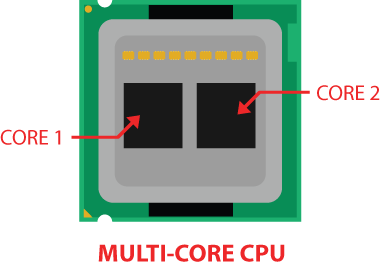-
-
products
-
resources
-
support
-
company
-
How do I Choose the Right CPU for my PC?
By Steve Horton February 21, 2011bottleneck, core, cpu, dual, multi2 CommentsWelcome to a series of articles about your PC and why it might not be running as swiftly as you’d like. Even the newest PC, especially an all-in-one model like a Dell or an HP, can have what are called bottlenecks, named for the narrow neck of a bottle. These key areas of your computer are the most susceptible to causing performance problems, and we feel that you should be made aware of them and how to prevent them from slowing down you PC. These articles will help you for when you are buying a new computer and when you are optimizing one that you already own.
Today’s Questions: How do I choose the right CPU for my PC?
What is a CPU and what is a Core?
Your CPU, or central-processing unit, can be thought of as the “brains” of your computer. It’s the square thing that sits in the center of the main board, or motherboard, of your computer. The CPU executes and controls almost everything your computer does.The “core” of the CPU is like the cerebral cortex – it’s the most crucial part that actually carries out the instructions. When you hear about an “Intel Core 2 Duo”, this refers to two cores.

Single Cores
Most desktop PCs five years old or more have what are called single-core CPUs. That means the CPU can only execute one instruction at a time. If you’re doing a ton of multitasking, have a lot of apps open, or are playing a computer-intensive game, having a single-core CPU can be a serious bottleneck! Even today, some laptops, especially netbooks, are made with single-core CPUs, making them unsuitable for anything other than word processing and light web browsing.Dual Cores
The first dual-core Pentium and AMD CPUs appeared in 2006 and 07, respectively. If you’ve got a desktop made around then or newer, odds are good it has at least two cores (called Dual Core). Dual core PCs are much better at handling lots of instructions at the same time, and if you’re like me and multitask 10 things at the same time, a dual core PC is a must! An example of a dual-core Intel machine is a Core 2 Duo; an example of a dual-core AMD CPU is the Phenom II. (Both my desktop and laptop are Phenom IIs.)Quad Cores
Very new PCs have four cores in them (quad core). Most of these started arriving just in 2010, and have spread across the mass market in 2011. It’s difficult to tell from just the brand name whether it’s a quad core, so you’ll have to look closer for a “quad” or “X4” after the end of it. That said, Intel’s i7 processor is almost always quad core, and AMD’s Phenom II X4 has that handy X4 at the end, to let you know that, yes, it does have four cores. Both the Intel and the AMD have dropped in price significantly. Newer games, especially, take full advantage of a quad-core processor to provide maximum gameplay. If you’ve got the means, I highly recommend picking one up.More Cores
The first consumer models with more than four cores are just starting to arrive. These are very pricey and are really only for the most hardcore gamers or those with extraordinary requirements, such as graphic designers, 3D graphics programmers, or architects.It’s Not That Easy
Even though most CPUs are removable (this is called ZIF, or zero-insertion force; a simple lever lets you take a CPU out easily), it’s not very likely that you’ll be able to pop our your single-core CPU and drop in a multi-core one. The entire motherboard (the main board inside your computer) has to be tailored to work well with such a CPU. If you’re tackling building your own PC from scratch, then getting a CPU and a motherboard that matches is a must. For those less tech savvy, buying an entire PC at once will ensure that the motherboard and CPU are designed to work well together.What to Look For
If you’re buying a new PC from a store, look at the specifications. If you’re buying online, do likewise. If you’re not sure how many cores it has, Google the processor name and find out. Your new PC should be at least dual-core, if not quad-core. Even if all you use it for is a Web browser, things like Flash-based games and YouTube video consume a lot of resources. Having those extra cores will reduce or eliminate the CPU bottleneck completely. Now that you’re armed with this knowledge, you’ll be much more informed when shopping for a new PC!Was this post helpful?YesNoFree Driver Updates
Update your drivers in less than 2 minutes to enjoy better PC performance - Free.
Free Driver Updates
Update your drivers in less than 2 minutes to enjoy better
PC performance - Free.
Didn't find your answer?Ask a question to our community of experts from around the world and receive an answer in no time at all.most relevant recent articles Pin It on Pinterest
